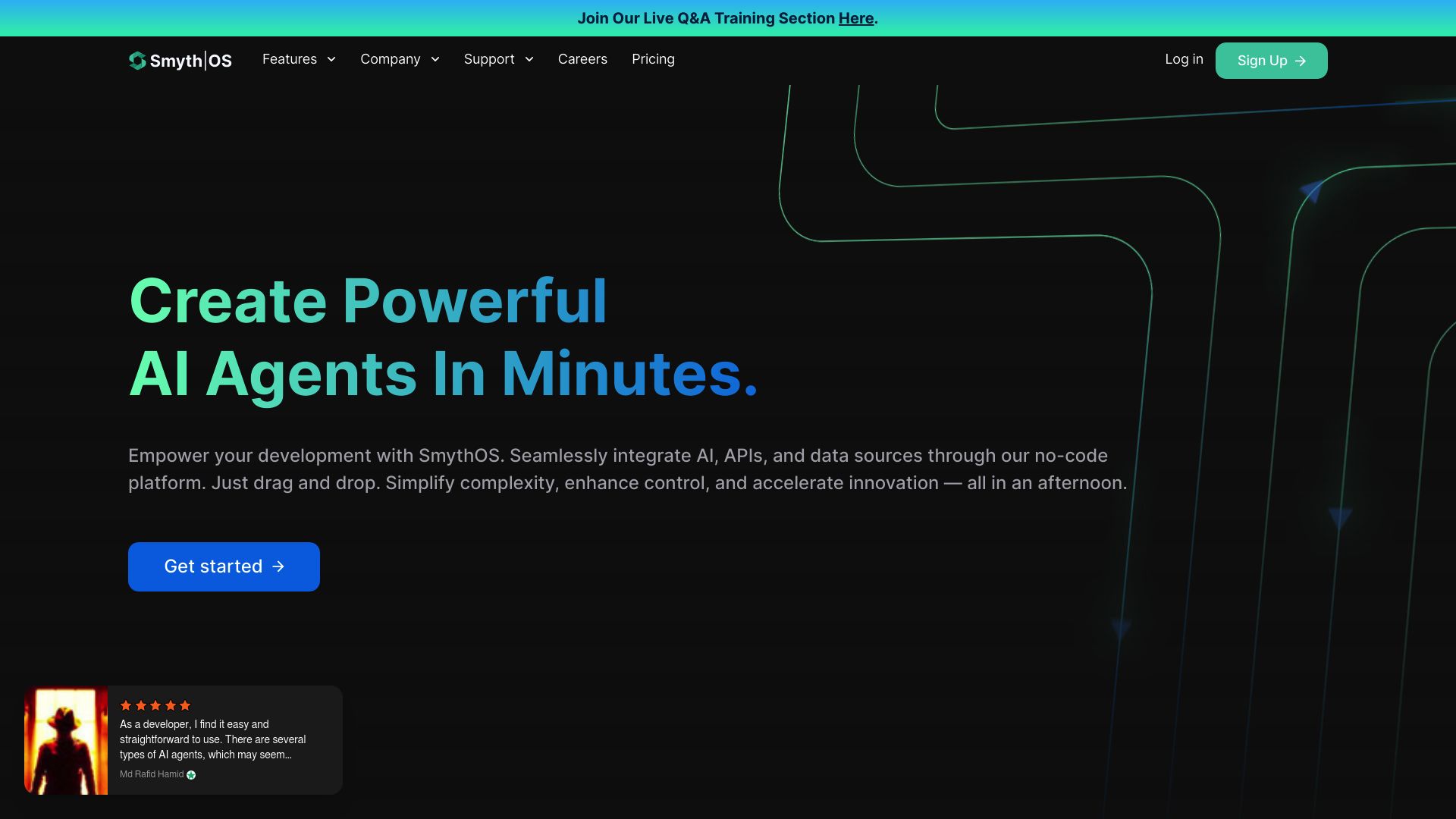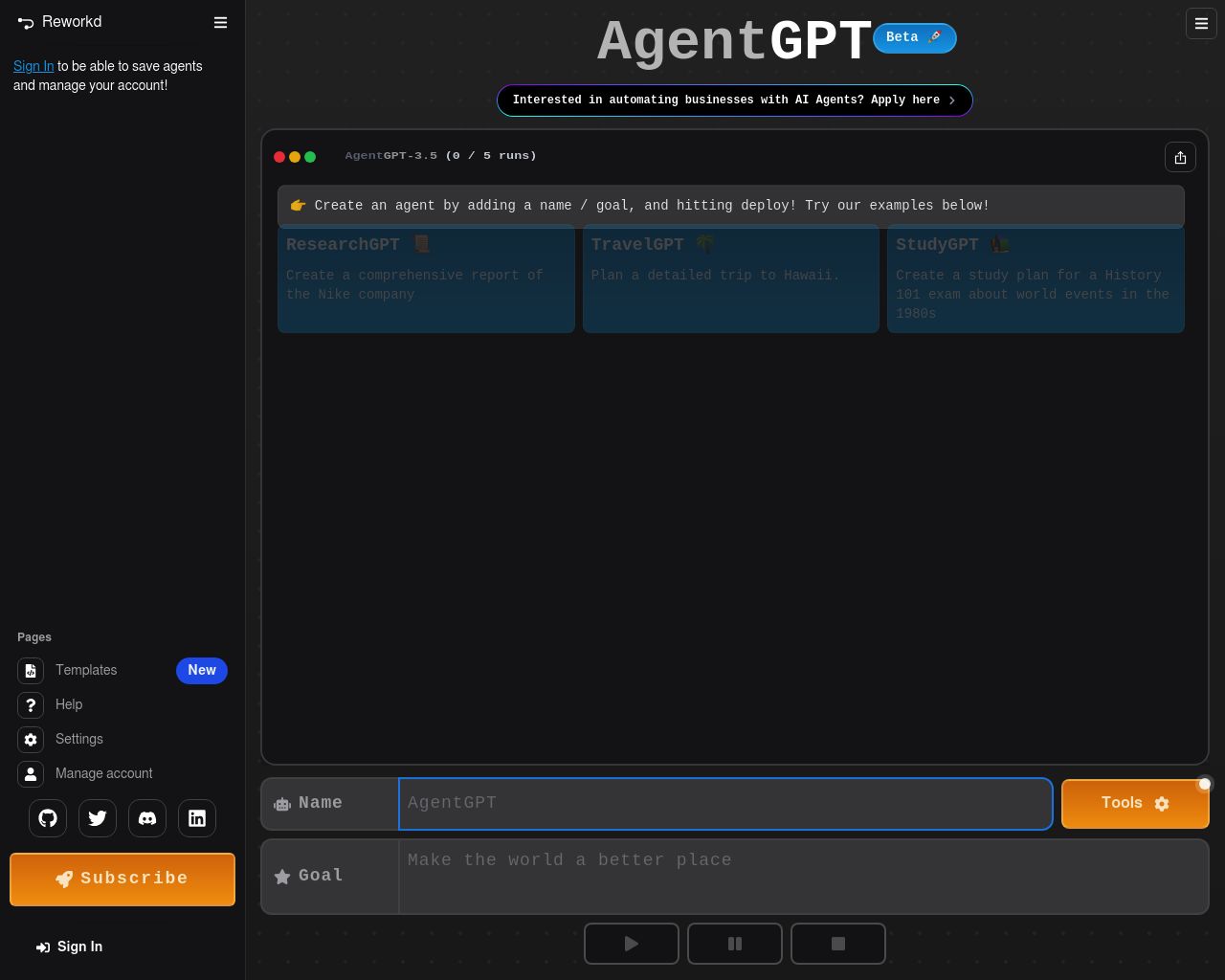Comparing AI Agent Builders: SmythOS vs AgentGPT
AI agent development platforms SmythOS vs AgentGPT empower users to build sophisticated AI solutions, but key differences set them apart. SmythOS offers enterprise-grade features, including advanced deployment options, extensive integrations, and robust security measures. Its drag-and-drop interface and support for multiple AI models cater to both technical and non-technical users.
AgentGPT focuses on accessibility, providing a user-friendly environment for creating goal-oriented AI agents. This comparison explores each platform’s strengths, deployment capabilities, and integration ecosystems to help readers choose the best solution for their AI development needs.
SmythOS Overview
SmythOS revolutionizes AI agent development with its powerful, user-friendly platform. We’ve engineered a comprehensive solution that empowers users to create, deploy, and manage sophisticated AI agents without extensive coding knowledge.
Our drag-and-drop interface simplifies complex workflow creation, allowing users to build AI agents that integrate seamlessly with various data sources, APIs, and AI models. SmythOS supports deployment across multiple platforms, including Google Vertex, Microsoft Copilot, and Amazon Bedrock, offering unparalleled flexibility in how AI agents function—whether as chatbots, backend APIs, or even Alexa skills.
SmythOS revolutionizes AI agent development with its powerful, user-friendly platform…empowering users to create, deploy, and manage sophisticated AI agents without extensive coding knowledge.


SmythOS excels in its integration capabilities, supporting a wide range of AI models and tools. We offer pre-built API integrations with popular services like Slack, Trello, GitHub, and Stripe, streamlining the development process. Our platform’s versatility extends to multimodal support, enabling AI agents to handle various data types, including images and text.
SmythOS excels in its integration capabilities, supporting a wide range of AI models and tools…enabling AI agents to handle various data types, including images and text.
Security and scalability form the cornerstone of our design philosophy. SmythOS incorporates robust data encryption, OAuth support, and scalable architecture to meet enterprise-level requirements. We’ve also implemented features for debugging, workflow inspection, and performance monitoring, ensuring transparency and reliability in agent operations.
While SmythOS offers a powerful suite of tools, users should be aware that mastering its full potential may require some learning investment. However, our comprehensive documentation and support resources significantly flatten this learning curve, making advanced AI agent development accessible to a broader audience.
AgentGPT Overview
AgentGPT empowers users to create and deploy customizable autonomous AI agents directly in a web environment. Unlike traditional chatbots, AgentGPT focuses on achieving broad, goal-oriented tasks through its web-based platform.


The platform offers a range of features, including user authentication, agent run saving and sharing, dynamic translations, and AI model customization. AgentGPT’s use of vector databases for memory management allows AI agents to retain execution history and access long-term memory, enhancing their functionality over extended periods.
AgentGPT’s use of vector databases for memory management allows AI agents to retain execution history and access long-term memory, enhancing their functionality over extended periods.
Developers and technical teams benefit from AgentGPT’s API integrations and advanced AI capabilities. The platform supports various foundation models and integrates with Hugging Face, expanding the possibilities for AI agent creation. Business leaders and enterprise teams will appreciate AgentGPT’s scalability and security features, including data encryption and OAuth support.
For non-technical users, AgentGPT provides a visual builder and no-code options, making AI agent creation accessible to a wider audience. The platform’s ability to deploy agents as APIs, webhooks, or chatbots offers flexibility for various use cases.
AgentGPT’s vision centers on empowering individuals and businesses by streamlining operations, boosting efficiency, and enabling informed decision-making. However, users should be aware of potential limitations in customization options and the complexity of integration with existing systems.
As the AI landscape evolves, AgentGPT continues to adapt, reflecting a collaborative and inclusive development approach. Its ongoing improvements aim to address challenges in scalability, data privacy, and ethical AI practices, positioning it as a versatile tool in the rapidly advancing field of AI agent development.
Feature Comparison
SmythOS and AgentGPT offer powerful AI agent development capabilities, but with notable differences in their feature sets. SmythOS provides a more comprehensive and enterprise-ready solution, while AgentGPT focuses on accessibility and ease of use for a broader audience.
SmythOS excels in its advanced deployment options and integration capabilities. We offer deployment as APIs, webhooks, scheduled agents, and even GPT models, providing unparalleled flexibility for various use cases. Our platform supports a wide range of foundation AI models and integrates seamlessly with Hugging Face, expanding the possibilities for AI agent creation. AgentGPT, while user-friendly, has more limited deployment options and may not offer the same level of integration with external AI models and tools.
In terms of core components, SmythOS stands out with its robust hosted vector database, enabling efficient management of large-scale data for AI agents. We also provide advanced features like classifiers and logic components for building complex workflows. AgentGPT’s offerings in these areas are less extensive, potentially limiting the complexity of agents that can be created on their platform. Additionally, our security features, including data encryption and OAuth support, position SmythOS as a more suitable choice for enterprise-level deployments where data protection is paramount.
Feature Comparison Table
| SmythOS | AgentGPT | ||
|---|---|---|---|
| CORE FEATURES | |||
| Visual Builder | ✅ | ❌ | |
| No-Code Options | ✅ | ❌ | |
| Explainability & Transparency | ✅ | ❌ | |
| Human-AI Interaction | ✅ | ❌ | |
| SECURITY | |||
| Constrained Alignment | ✅ | ❌ | |
| IP Control | ✅ | ❌ | |
| COMPONENTS | |||
| Foundation AIs | ✅ | ❌ | |
| Data Lakes | ✅ | ❌ | |
| DEPLOYMENT OPTIONS (EMBODIMENTS) | |||
| Staging Domains | ✅ | ❌ | |
| Production Domains | ✅ | ❌ | |
| Deploy as Scheduled Agent | ✅ | ❌ | |
| DATA LAKE SUPPORT | |||
| Sitemap Crawler | ✅ | ❌ | |
| YouTube Transcript Crawler | ✅ | ❌ | |
Conclusion
SmythOS and AgentGPT both offer powerful AI agent development capabilities, but SmythOS stands out as the superior choice for businesses seeking a comprehensive, scalable, and secure AI solution. Our platform’s drag-and-drop interface, extensive integration ecosystem, and versatile deployment options empower users to create sophisticated AI agents without extensive coding knowledge.
While AgentGPT provides a user-friendly environment for creating goal-oriented AI agents, it lacks the depth and flexibility offered by SmythOS. Our support for multiple AI models, advanced deployment options, and robust security features make us the ideal choice for enterprise-level applications. SmythOS excels in complex scenarios requiring multimodal interactions, problem-solving capabilities, and seamless integration with existing systems.
For businesses looking to harness the full potential of AI, SmythOS offers unparalleled value. Our platform’s ability to deploy agents as APIs, chatbots, or scheduled tasks, combined with our hosted vector database and advanced logic components, enables the creation of truly intelligent and autonomous AI systems. Whether you’re a developer seeking advanced customization options or a business leader focused on scalability and ROI, SmythOS provides the tools and flexibility to meet your needs.
Experience the future of AI agent development with SmythOS. Create a free account today and discover how our platform can transform your business processes, boost productivity, and drive innovation. With our 30-day money-back guarantee and unlimited agent creation, you can explore the full potential of AI-powered automation risk-free. Unleash the power of AI for your business and stay ahead in the rapidly evolving digital landscape with SmythOS.
Last updated:
Disclaimer: The information presented in this article is for general informational purposes only and is provided as is. While we strive to keep the content up-to-date and accurate, we make no representations or warranties of any kind, express or implied, about the completeness, accuracy, reliability, suitability, or availability of the information contained in this article.
Any reliance you place on such information is strictly at your own risk. We reserve the right to make additions, deletions, or modifications to the contents of this article at any time without prior notice.
In no event will we be liable for any loss or damage including without limitation, indirect or consequential loss or damage, or any loss or damage whatsoever arising from loss of data, profits, or any other loss not specified herein arising out of, or in connection with, the use of this article.
Despite our best efforts, this article may contain oversights, errors, or omissions. If you notice any inaccuracies or have concerns about the content, please report them through our content feedback form. Your input helps us maintain the quality and reliability of our information.
